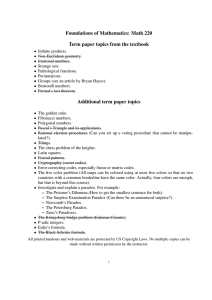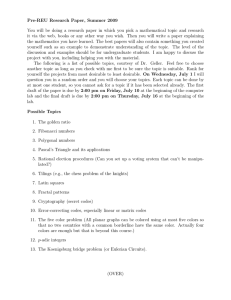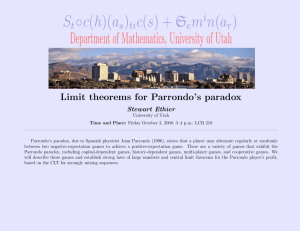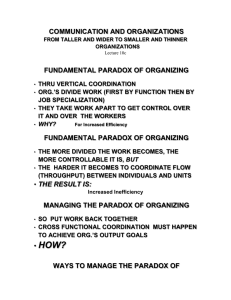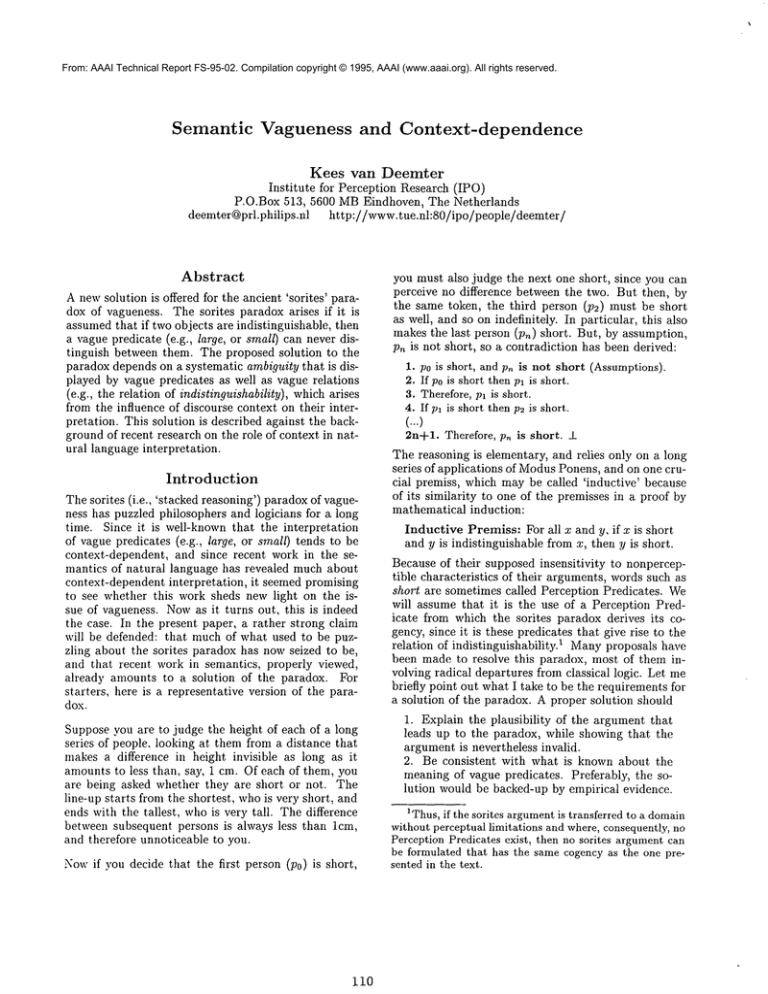
From: AAAI Technical Report FS-95-02. Compilation copyright © 1995, AAAI (www.aaai.org). All rights reserved.
Semantic
Vagueness
and Context-dependence
Kees van Deemter
Institute for Perception Research (IPO)
P.O.Box 513, 5600 MBEindhoven, The Netherlands
deemter@prl.philips.nl
http://www.tue.nh80/ipo/people/deemter/
Abstract
A newsolution is offered for the ancient ’sorites’ paradox of vagueness. The sorites paradox arises if it is
assumedthat if two objects are indistinguishable, then
a vague predicate (e.g., large, or small) can never distinguish between them. The proposed solution to the
paradox depends on a systematic ambiguity that is displayed by vague predicates as well as vague relations
(e.g., the relation of indistinguishability), whicharises
from the influence of discourse context on their interpretation. This solution is described against the background of recent research on the role of context in natural language interpretation.
Introduction
The sorites (i.e., ’stacked reasoning’) paradox of vagueness has puzzled philosophers and logicians for a long
time. Since it is well-known that the interpretation
of vague predicates (e.g., large, or small) tends to be
context-dependent, and since recent work in the semantics of natural language has revealed much about
context-dependent interpretation, it seemed promising
to see whether this work sheds new light on the issue of vagueness. Nowas it turns out, this is indeed
the case. In the present paper, a rather strong claim
will be defended: that much of what used to be puzzling about the sorites paradox has nowseized to be,
and that recent work in semantics, properly viewed,
already amounts to a solution of the paradox. For
starters, here is a representative version of the paradox.
Suppose you are to judge the height of each of a long
series of people, looking at them from a distance that
makes a difference in height invisible as long as it
amounts to less than, say, 1 cm. Of each of them, you
are being asked whether they are short or not. The
line-up starts fl’om the shortest, whois very short, and
ends with the tallest, whois very tall. The difference
between subsequent persons is always less than lcm,
and therefore unnoticeable to you.
Nowif you decide that the first person (P0) is short,
ii0
you must also judge the next one short, since you can
perceive no difference between the two. But then, by
the same token, the third person (P2) must be short
as well, and so on indefinitely. In particular, this also
makes the last person (p~) short. But, by assumption,
pn is not short, so a contradiction has been derived:
1. po is short, and p,, is not short (Assumptions).
2. If po is short then pl is short.
3. Therefore,pl is short.
4. If pl is short then p2 is short.
(..)
2n+l. Therefore, p~ is short. _k
The reasoning is elementary, and relies only on a long
series of applications of ModusPonens, and on one crucial premiss, which may be called ’inductive’ because
of its similarity to one of the premisses in a proof by
mathematical induction:
Inductive Premiss: For all x and y, if x is short
and y is indistinguishable from x, then y is short.
Because of their supposed insensitivity to nonperceptible characteristics of their arguments, words such as
short are sometimes called Perception Predicates. We
will assume that it is the use of a Perception Predicate from which the sorites paradox derives its cogency, since it is these predicates that give rise to the
relation of indistinguishability. 1 Manyproposals have
been made to resolve this paradox, most of them involving radical departures from classical logic. Let me
briefly point out what I take to be the requirements for
a solution of the paradox. A proper solution should
1. Explain the plausibility of the argument that
leads up to the paradox, while showing that the
argumentis nevertheless invalid.
2. Be consistent with what is known about the
meaning of vague predicates. Preferably, the solution would be backed-up by empirical evidence.
1Thus,if the sorites argumentis transferred to a domain
without perceptual limitations and where, consequently, no
Perception Predicates exist, then no sorites argumentcan
be formulated that has the same cogency as the one presented in the text.
3. Use as few unmotivated departures from classical logic as possible. A departure can only be
motivated by an appeal to (2).
I will argue along the following lines: Empirical research in the last ten years has revealed that contextdependence is a pervasive phenomenonin natural language that affects expressions of all kinds, including
vague ones. In line with this research, it is hypothesized that vague predication must always involve at
least two arguments: an object judged and a set of
elements with which this object is being compared.
Consequently, vague predication is incomplete without a ’comparison set’, in comparison with whose elements the predication must be understood. Nothing is
small or large per se, but only in comparisonwith other
things -- As will becomeclear later, this idea is not restricted to vague predicates. In particular, the relation
of indistinguishability will also prove to be dependent
on a ’comparisonset’ for its interpretation. Predicates
and relations alike take their comparison sets from the
linguistic and nonlinguistic context of the utterance.
In order to deal with the sorites paradox, the argument
itself is viewed as a piece of discourse during which
a comparison set is built up. As a result, when the
context-dependence of the vague expressions in the argumentis taken into account, it turns out that the Inductive Premiss of the sorites argument becomes ambiguous. What makes sorites arguments plausible is
the fact that, in some of its interpretations, the premiss supports the argument, but then it fails to be
true by virtue of the meaning of the vague predicate;
in other versions, it is true by virtue of the meaningof
the predicate, but then it does not support the argument. As we will see, this pattern of explanation holds
up even in the case of vague expressions that are not
normally viewed as context-dependent.
The current approach to the paradox differs from most
other accounts that I knowof in that it does not propose a drastic change in the underlying logic. In particular, there is no need to assign unusual interpretations to the conditional, the negation, or the universal
quantifier. On the other hand, the interpretation of
non-logical constants changes, in that they acquire an
additional argument place for a comparison set.
Short and small will be our paradigmatic vague predicates, but everything that will be said is meant to be
applicable to most vague predicates of the kind that,
intuitively speaking, ’measure’ something. Such predicates have been studied in standard measurement theory, and their properties are well established. 2 The
2The vague predicates (e.g., ’small’) of standard measurement theory are predicates that correspond with perceptual relations (e.g. ’visibly smaller’) that form
semi-order. A structure (A,R), where R is the perceptual relation (later denoted ’-4’), is a semi-orderiff (1)
sentence ’x is small’ (or ’x is short’) will often be abbreviated by the formula S(x). With the comparison
A
set A as an additional argument, we will write S(x)
to abbreviate ’x is small with respect to A’. For a
more elaborate discussion, the reader is referred to Van
Deemter (to appear).
Context-dependence
in Natural
Language
The notion of context has long been recognized as an
important concept in linguistics, especially in formal
treatments of the semantics of indexical expressions
(Montague 1974, Kaplan 1979). Recent years have
seen a rapidly increasing numberof applications of the
3notion of context inside as well as outside linguistics.
One prominent example is Situation Semantics, which
views meaning as a relation between utterance situations (nonlinguistic context, that is) and described situations. An example that is more directly relevant to
our current endeavour is the tide of so-called dynamic
theories of anaphora (Kamp 1981, Heim 1982, Barwise 1987), which started to explicate anaphora as
primarily contextual phenomenon. According to these
theories, an anaphoric pronoun is only appropriate in
a context in which a suitable antecedent for it has been
introduced. For instance, if the following pieces of discourse constitute the beginning of a story, then (1)
inappropriate in a sense in which (2) is not.
1.* (a) Yesterday, I saw it. (b) A dog barked.
2. (a) Yesterday, I saw a dog. (b) It barked.
One might say that (2a) adds an individual to the context that is then taken up by it in (2b). The occurrence of it in (1) is not legitimized by previous context.
The main task of an anaphoric theory is then to define under what circumstances a would-be antecedent
is accessible to a given anaphor. This ’contextual’ perspective on anaphora is, by now, widely accepted.
This contextual perspective on things anaphoric has
gradually been broadened to include more and more
kinds of expressions that depend on context for their
interpretation.
For example, Barbara Partee and others have analysed the context-dependence of implicit
arguments of words such as local and contemporary
along ’anaphoric’ lines (Partee 1989, Condoravdi and
Gawron, to appear). Perhaps most relevant for present
Vx(~xRz), (2) Vxyzu((xRy&zRu) ---* (xRu v zRy)), and
(3) Vxyzu((xRy~yRz) --* (wRuVuRz)). Note that a semiorder allows for indistinguishable elements~i.e.~ elements
x, y such that. x 5~ y, -~(xRy) and -~(y_Rx). For an introduction, see Suppes1963.
3A recent attempt at constructing a unifying theory of
the notion of context has been madeby John McCarthyand
others (McCarthy1987, Buva~ and Mason1993, Buva~ et
al., to appear). Wewill not use such a general perspective
on context, concentrating on one that is more convenient
as long as only vaguenessis at stake.
purposes is a research track that was started off in
Westerst£hl 1985, and where generalized quantifiers
can be restricted to contextually available ’context
sets’. Subsequent work has extended this approach
and shown that noun phrases (NPs) of all sorts, and
expressions of other categories as well, can be contextdependent (e.g., Carter 1987, Van Deemter 1992).
Moreover, the principles that govern the accessibility
of context sets turned out to bear close resemblance
to those governing the availability of antecedents of
anaphoric pronouns. Thus, the possibility begins to
present itself of a unified account of context-dependent
phenomena, of which pronominal anaphora is just a
special case.
be true, while the universally quantified formula that
has these implications as its instantiations maystill be
false, because its addition to the context would cause
the context to become incoherent. Thus, if a suitable domain is chosen, the inductive premiss of the
sorites argument becomesfalse. Yet, all instantiations
of the flawed premiss are true, and this explains why
the paradox has intuitive appeal. A similar solution
has been proposed by Veltman and Muskens5 (Veltman 1987).
Context-based analyses of NPs containing vague adjectives 4have also been forthcoming. An early account
is the one in Kamp 1975, which was worked out in
much more detail by Ewan Klein. Consider the sentence ’Some small elephant runs’. According to Kamp
and Klein, the set of elephants functions as a comparison set that somehowsets the standard for what
counts as small (Klein 1980). This explains, for example, whya small elephant is not necessarily a small
animal, since elephants are, on average, larger than
the average animal.
However,this raises the following question: if a vague
adjective can be dependent on local (i.e., NP-internal)
context, then cannot it also be dependent on global
(i.e., NP-external) context? After all, the situation
the sorites paradox is one in which no local comparison set is available, as in predicative use. Consider a
sentence of the form ’x is small’. Howis the standard
for smallness determined if it is not through local context? The facts suggest that global context comes to
the rescue: the standards of smallness are determined
by a comparison set that has been built up during a
discourse. There are hints of this idea in Kamp1975,
though no formal account.
In the remainder of this paper, a solution to the paradox will be defended that makes use of the notion of
global context, modeledas a comparisonset. The starting point is that it makeslittle sense to ask, of a given
object, whether it is small or large unless a comparison
set is specified either implicitly or explicitly. Thus, a
vague predicate such as small is modeled as a relation
between an individual and a comparison set. For the
sake of argument, it will be assumed that this relation is a precise (i.e., non-vague) one. Of course, this
simplifying assumption may be challenged (e.g., Zadeh
1975), but what I intend to show is that the solution
to the paradox does not depend on this.
Context, in the present proposal, is built up during discourse, in the spirit of dynamictheories of meaning: a
discourse is parsed from left to right, and individuals
are added to the context as a by-product. To attain
the full theory of the semantics of vagueness, many
details would have to be sorted out. But fortunately,
the structure of a sorites argument makes it an extremely simple kind of discourse: subsequent elements
6are judged to be small, and then added to the context.
The proposal of this paper makes use of some of the
same building blocks as its predecessors, but amounts
to a quite different solution of the paradox. At the root
of the difference lies the fact that the current proposal
takes the similarities between vagueness and anaphora
seriously. As was stressed in van Deemter 1994, this
anaphoric perspective predicts that the interpretation
of a vague predication suffers from an intrinsic ambi-
Global context was taken into account in a series of
later proposals for the semantics of vagueness, including Kamp1981 and Veltman 1987. In this work, context does not play the role of a comparison set, but is
only used to enforce certain kinds of coherence conditions. For instance, in Kamp1981, a universally quantified formula is false if the addition of the formula to
the context causes the context to become’incoherent’.
One thing that makes a context incoherent is when it
contains elements a and b that are indistinguishable,
while there is a vague predicate S that is true of a and
false of b. Due to this move, Kampcan let each of
a series of implications of the form S(pi) --~ S(p~+I)
4According to Kamp,the insight that a noun can act
as a comparisonset for a vaguepredicate, is ’probably too
old to be traced back with precision to its origin’ (Kamp
1975), p.127.
112
5Veltman and Muskens’ proposal, which makes use of
an idea from Goodmanand Dummettthat will also play
an important role in the present proposal, is discussed at
somelength in van Deemter1994.
6It would be worthwhile to study the contextdependencyof vagueexpressions in greater empirical detail.
For example, when a complex NPcontains a vague adjective, local and global factors interact. Thus, if ’Somesmall
elephantsrun’ refers to the elephants in a zoo, one possible
comparisonset is the entire set of Elephants, and another
is Elephants gl (Animals-in-the-Zoo). But Animals-in-theZoo seems to be a less natural comparisonset. Since our
present purposeis to explain the sorites paradox,it suffices
to deal with predicative uses of vagueadjectives, as in ’x is
small’, and in such cases global context-dependenceis the
only thing to worry about.
guity problem, since it is sometimes unclear whether a
given expression must be interpreted as anaphoric or
not. It will be argued that this ambiguity of vague expressions is exploited in the sorites argument, and the
paradox will be analysed as a fallacy that is based on
the ambiguity of one of its premisses.
Context-dependent
sorites
versions
paradox
and some other element arises if and only if the difference in size between h and this other element exceeds some constant value. This constant will now be
assumed to be the same for all h and called a Just Noticeable Difference (JND) (Suppes and Zinnes 1963).
Relativized indistinguishability is defined as follows:
(X ~" y)A ¢:FDef -~(X "< y)A ~2 ..~(y
of the
In effect, ’indistinguishability with respect to A’ implies that A provides no help element to tell x and y
apart. It is easy to see that x,-- y ~ (x,--y){~}
(x --~ y){Y}¢~ (x ~ y){~’Y}. Relativized indistinguishability has manyinteresting properties such as, for example, transitivity.
Also, the Goodman/Dummett
construction is stable, in the sense that iteration does
7not change it.
In the current section, it will be shown that when
comparison sets are taken into account, the inductive
premiss of the sorites argument becomes ambiguous,
and that there exist highly consequential differences
between someof its interpretations.
Given our ’contextual’ perspective, what are the possible versions of the crucial premiss? There are three
clauses in the premiss to consider: the clause in which
x is assumed to be small (S(x)), the one in which x
and y are compared(x --. y), and the one in which y
concluded to be small (S(y)). Let us first look at the
clause in which x and y are compared. The relation of
being visibly smaller than something will be viewed as
primitive, abbreviated as -< (Inverse: ~-).
At this point we have a plausible candidate for a relativized version of the clause that says ’x is indistinguishable from y’. So how about smallness, how can
that notion be relativized to a comparison set? Let us
simplify and assume that there is no ambiguity in the
notion of ’Smallness with respect to a comparison set
A’, and that it involves a comparison between two sets:
the set of elements in A that. are visibly smaller than
the element x that is judged (also abbreviated K[x]A),
and the set of elements in A that are visibly larger than
it (also abbreviated G[x]A). This is expressed in the
following meaning postulate, which is illustrated by a
picture:
x -4 y ¢* x is visibly smaller than y.
x ~ y ¢* y is visibly smaller than x.
x ..~y v~ -~x -< y &-~y~ x.
Howcan context be relevant for the interpretation
of (in)distinguishability?
One interesting answer has
been suggested in Goodman1966 and examined more
closely in Dummett1975: the elements that a context makes available can be viewed as resources that
can help distinguish observed individuals. Thus, one
might first define ’x is smaller than y with respect to
A’ (hence (x -< y)A) and then ’x is indistinguishable
from y with respect to A’ (hence (x ... y)A). Wewould
like to think of (x -< y)A as expressing a relation that
involves observation assisted by reason. Therefore, it
is natural to let (x -< y) have (x -< y)A as a logical
implication, and since we do not want to prejudge the
question of whether x and y themselves must be elements of A, the clause x -~ y will be included as a
separate disjunct:
Comparison Postulate:
S(X) A "~Fne
f
I{Y ¯ A: y >-- x}] is greater than I{Y ¯ A: x ~ y}].
............
yV
3b E A : (h -’< y &~h -< x) v (x -.< h &-~y .< h)).
For example, in the following situation, h helps to tell
x and y apart:
Y
x
-<
h
X
............
Whether or not x is small thus only depends on the
cardinalities of K[x]A and G[x]A. The elements in between K[x]A and x are not taken into account, and
neither are those in between x and G[x]A. It is argued
in Deemter (to appear) that little hinges on whether
a particular usage of small satisfies the Comparison
Postulate, as long as some much more general meaning postulates are obeyed. But note that even if the
Comparison Postulate is taken for granted, there are
plenty of ways to render the inductive premiss of the
sorites argument. As with anaphora, there is a resolution problem: each of the three clauses can, in principle, be relativized to any context set. The following
options seem reasonable: each of the three clauses may
be interpreted (a) with no context set at all, (b)
respect to some context set A that is given at the beginning of the argument, or with respect to (c) AU{x},
(x -4 y)A ~=~Def (X
~l
..<
y
)
Assuming
thath~A,thedefinition
implies
that,in this
example,(x ~< y)A One way to motivatethisis
arguingthaty mustbe biggerthanx, whichfollows
if one assumes that a perceptible difference between h
113
~These
observations
were also
made by Frank
Velt-
man and Reinhard Muskens who show that the Goodman/Dummett
notion of indistinguishability does not lead
to the sorites paradox (Veltman1987).
(d) A U {y}, and (e) A t9 {x, y}. As a result, there
125 different versions of the inductive premiss.
(S(x)
Getting to grips with all these versions of the paradox
may seem a daunting task, but their number can be
reduced. Firstly, let us, in accordance with a dynamic
perspective on interpretation, assume that elements in
a context set are always only assembled from left to
right. Consequently, the only three options for the
first clause, S(x), are (a), (b), or (c). The element
simply hasn’t come up yet.
(x - y)) --->
A
i
]
J
l
l
-
[ A U {x}
A
f
A
J A U {x}
The second version of the premiss cannot be falsified.
Such a version of the premiss, which must be true due
to the meaning of the terms in the premiss, will be
called valid. On the other hand, this version does not
support the sorites argument. To see that it is valid, assume S(x) A while not S(y) AU{x}. Thus, we have A
S(x)
and not S(y) m. Nowgiven the Comparison Postulate,
this can only be true if some element h of A behaves
differently towards x and y, in other words, if h -~ y
while not h --< x, or if x -< h while not y -< h. But
under such circumstances, h fulfils the function of a
help element in the sense of Goodman/Dummett,contradicting (x ,,, y)A. So, this version of the premiss
is valid. To see that it does not support the paradox,
let Size be a function that maps individuals to their
(real-valued) size in the relevant dimension. Let x0
an element that is judged to be small with respect to
the comparison set A0. Then Size(x0)+ JND functions
as an upper limit on the sizes of elements that can be
inferred, by the inductive premiss, to be small. The
argument goes
S(xo) A° and (x0 "" Xl) AO, therefore
S(xl)A°u{~°}; also, (xl ~ x=)A°U{*°},therefore
S(x2 )Ao U{~o,~};etcetera.
Note that x0 is an element of all comparison sets
after the initial one. As soon as one arrives at x~
such that (x0 -.~ xi-1) and (x0 --< x~), then (xi-1
xi)Au{~o,~,~2..... ~-2}. At that point, xi is not indistinguishable from its predecessor (with respect to the
relevant comparison set) and the argument comes to
halt. -- A more detailed illustration of how this can
happen is offered in the next section.
However, this number can be greatly reduced. (x "y)A and (x ,,~ y)AU{x,y} are equivalent, and this reduces the numberof options for the indistinguishability clause to two: plain ,-~ and ’,-~ with respect to A’.
To further reduce the number of options for the other
two clauses, discard option (a) for the clauses S(x)
and S(y), since S requires that some comparison set
specified. At this point, we are left with the following
options, in which x, y and A are universally quantified:
(Indicated are the sets to which the respective clauses
maybe relativized. A dash indicates the option of using no context set at all. A, x, and y are universally
quantified.)
A
i
A U {x} ]
J
[
A
Neither of these two versions leads to a sorites paradox. The first one is easily falsified. Let A contain z
as its only element, and assume x can just barely be
discerned to be smaller than z. In other words, the
difference in size between them equals a JND. Consequently, if x -,- y, while y is larger than x, then y is not
distinguishably (i.e., discernably) smaller than z. Under these circumstances, G[x]A = {z} and K[x]A = 0,
while G[y]A = K[y] A = 0, and consequently A,
S(x)
while not A.
S(y)
Secondly, let us assumethat the formula x ,-- y is symmetric, in that it either introduces both x and y into
the comparison set, or none of the two. Once more,
only three options are left: options (a), (b), and
Unfortunately, these two assumptions do not reduce
the options for the third clause, S(y), however, so we
are still left with 45 versions.
(S (x) &
(x - y)) ....> S(y)
A
A U {x}
A U {y}
A U ~x,y}
But most of these options are logically equivalent if
’smallness with respect to a comparison set’ is interpreted as in the Comparison Postulate. It will never
make any difference for the truth of the S-clauses
whether the comparison set for a certain clause equals
.4, A t_) {x}, A U {y}, or A u {x, y}, given that x and
y are perceptually indistinguishable. In other words:
(b), (c), (d) and (e) are logically identical in
of the two S-clauses. Consequently, only one version
of the two S-clauses needs to be distinguished. For
reasons of general plausibility in a dynamicsetting, we
select a version in which S(x) is evaluated with respect
to A, while S(y) is evaluated with respect to A U {x}:
To sum up, when comparison sets are brought to
bear on vague predicates, the inductive premiss of
the sorites argument displays an ’anaphoric’ ambiguity, that hinges on the choice of comparison sets for
the respective clauses of the premiss. The premiss becomes ambiguousbetween two sorts of interpretations.
One is strong enough to support the sorites argument
but is invalid; the other is too weak to support the
114
..
paradox, but happens to be valid. I believe that this
ambiguity is a plausible cause of confusion on the part
of language users.
At this point, the invalid version of the inductive premiss need not occupy us much. The valid version,
however, which employs Goodman/Dummett-style indistinguishability calls for someillustration.
Illustration:
Howthe paradox breaks
down.
To illustrate howcomparison sets cause the version of
the sorites argument that makes use of the Comparison
Postulate for smallness and the Goodman/Dummett
notion of indistinguishability to break down, let us go
through an actual sorites argument. Weare dealing
with the following version of the inductive premiss:
Premiss P:
VyVyVA ((S(x) A & (x ,~ y)A) S( y)AU{~}).
Imagine a line-up of individuals (Martians, say) that
are just 1 mmapart, starting at 0.60 m and ending at
1 m. Let us number them from x0 upwards: x0 has a
length of 0.60, and xi has length 0.60 + i mm.Let a
JNDequal 10 mm.Wewill assume that the initial standard of comparison is something like one’s own height.
In mycase this is sufficiently taller than 1 m, so the
first Martian will be called small. Nowthe following is
predicted, where the letter I denotes the speaker:
O. S(xo) A, since A = {I}, while G[xo]A = {I} and
K[Xo] A = 0
1. S(xl) A, since A = {I, xo}, while G[xl] A = {I} and
K[Xl] A ~-~ 0
9. S(x9)A, since A -- {I, xo, ..,xs},
and K[xg]A = 0
and G[xg]A = {I}
10. ~S(XlO)A, since A = {I, xo, ..,xg},
{I} and I([xlo] A ---- {XO}.
x9 xlo
x0
k
and G[XlO]A =
I
)
-<
Somehow, the sorites argument must break down at,
or before, Xl0. There are prospective applications of P
from (0) to (1), from (1) to (2) ..... and from(9)
with different instantiations of x,y,A. For example,
one gets from (0) to (1) by chosing x :-- x0, y :-and A := {I}, observing that (xo " xl) U}, since both
are distinguishably smaller than the speaker. This
works until one arrives at step (10). By assumption,
x~0 is 1 mmtaller than xo, makingit, for the first time,
distinguishably taller than the initial element xo. As
a result, ~((x9"~ xlo)U’~°...... ~}), since (Xo"-- xg),
(xo -4 xlo). In other words: after having inferred that
x9 must be small, relative to the context at hand, there
happens to be no suitable object around to instantiate
the antecedent of P. Of course such an object might
have been around, for example, an element Xl0, that is
just 0.5 mmtaller than xo, and then another after Xlo,,
and so on. However, in that way one will always only
infer the smallness of elements that are smaller than
xl0, and no paradoxical conclusion is inferred. The
value Size(xo) + JNDfunctions as a limit: only x that
are smaller than this value (i.e., smaller than XlO) are
Goodman/Dummett-style indistinguishable
from x9.
Observe that, in this example, elements stop being
called small at precisely the same time when they
stop being Goodman/Dummett-style indistinguishable
from xg. Should our initial comparion set have consisted of two elements, I and an element I ~ that is just
1 mmtaller than I, then Xl0 would also have been
Goodman/Dummett distinguishable
from x9, but it
would still have been small, since G[xlo] A = {I,I’}
and K[xlo] A = {x0}.
Starting from this example, it is easily seen that the
paradox can break down in one of the following three
ways: (i) the case illustrated above, in which the argument breaks down through an element xi that has the
same G[xi]A as its predecessor, but an enlarged t([xi]A;
(ii) the same K[xi]A, but a diminished G[xi]A; or (iii)
through an element that is located in such a way that
G[xi] A and K[xi] A change at the same time.
So, why is the paradox flawed? Well, firstly, it was
assumed that a vague notion such as small requires
a comparison set. Nowwhatever finite set one takes
as the initial comparison set A0, the result is some
finite ’norm’, implying some upper limit on what is
small with respect to that norm. Of course, the norm
will change when newly-judged individuals enter the
comparison set. But, as long as the elements that are
judged are small with respect to the current comparison set, they will only cause the norm to go down:
s [[sAIlIf S(y) A, then [[sAu{v}[[ G
As a result, all the individuals (x0,x~,...) that are
added in the course of a sorites argument first leave
the norm of the initial comparison set intact, and in
the somewhat longer run, they cause the norm to become even stricter, causing an even earlier break-down
of the argument.
Let me point out that many interesting variations on
the theme of this construction can be conjured up,
including, for example, notions of indistinguishability
that contain a stochastic aspect, to account for the fact
that observers tend to be less than completely consistent in their judgments. These and other variations
are discussed at length in Van Deemter (to appear).
STheextension of small with respect to comparisonset
Ais denotedIlSall.
115
Conclusion
In the above, it was shown how the assumption that
vague predications involve an explicit or implicit comparison set bears on the sorites paradox, through ambiguities in what constitutes the comparison set for
the different clauses of the inductive premiss of the
sorites argument. In the introduction of this paper,
logical conservativity was defended to be an important
desideratum for a solution to the sorites paradox. So,
in how far can the current solution be regarded as logically conservative?
smallness, it is represented by means of a formula in
which A appears; in a context in which a superset A’
I.
of A is the comparison set, A is replaced by A
This paper has advocated an approach to the sorites
paradox of vagueness in which the notion of contextdependence plays a central role. This raises the question of whether vagueness must always involve contextdependence and how possible counterexamples affect
the current proposal.
It is at least conceivable that there exist vague predicates that are not context-dependent. For example,
their vagueness may result from perceptual or judgmental limitations, while the standards for comparison are invariable. A tentative example would be the
vague predicate healthy. Arguably, whether a person
is healthy is not dependent on the context in which the
person’s health is considered, but only on the requirements of survival and procreation. Let smoll be similar
to the adjective small, except that it is ’absolute’, like
healthy:
It has been noted that the only non-classical element
in the proposal consists of relativizations of atomic
clauses to comparison sets. Thus, a mechanism that
is often only implicit in natural languages was made
explicit in the logical object language. An alternative approach is also possible, which leaves comparison
sets implicit. Mimicking the work of Groenendijk and
Stokhof on Dynamic Predicate Logic (Groenendijk and
Stokhof 1991), one might use an object-language that
is syntactically equal to a variant of predicate logic,
while its semantics ensures that comparison sets are
provided. One might think of interpretive rules such
as the following (where Mis a model with universe
and interpretation function I, while A C_ E is a comparison set):
Smoll(x) ¢~De/ x -~
Somethingis smoll if and only if it is distinguishably
smaller than the speaker. Using the definiens of smoll..
an informal version of the inductive sorites premiss says
Inductive Premiss: For all x and y, if x -~ I
and y is indistinguishable from x, then y -~ I.
M,A ~ S(a)&S(b)
M,A~S(a) andM, AU{/(a)}
S( b),
where the individual denoted by a enters the comparison set once a has been interpreted. Thus, interpretation would become truly dynamic. Our main reason
not to ’go implicit’ is that it would have forced us to
rule out any ambiguities in the assignment of comparison sets, and ambiguity is a key element in the explanation of the paradox. Less crucially, it wouldalso
have tended to over-simplify the way in which comparison sets grow. For example, elements are not only
added to a comparison set, but also substracted, since
memories of the elements of comparison sets fade away
and becomeirrelevant.
Let us define, as before, the contextualized version
(x ~ y)A in Goodman/Dummett-style, while noncontextualized x --~ y is equivalent to something of the
form
! Size(y)- Size(x)l
Then what we see is the usual pattern:
1. Smoll(x) & x ,~ y ~ Smoll(y).
2. Smoll(x) &(x ,., y)A __~ Smoll
Version 1 is clearly invalid and supportive. To determine the status of version 2, one has to assume that
I E A, which seems natural enough. Consequently, 2
becomes valid for perfectly familiar reasons: suppose
Smoll(x) and -~Smoll(y), then x -~ I; but not y -~ I:
which implies -~(x ~ y)A. This shows that a vague
predicate need not be dependent on discourse context
to give rise to the kinds of ambiguities that help us to
understand the sorites paradox.
Our choice to keep references to context explicit has as
a consequence that the logic is monotonic in the following sense: If premisses are added to the premisses
of a valid argument, then a valid argument must again
result. If F ~ S(x) A, then also F U {qo} ~ S(X) A, no
matter what ~ is. The language of relativizations can
be embeddedin classical logic by writing S(x) A as a
two-place relation: S(x,A). Intuitively, this language
is used to model a non-monotonicsituation. After all,
a natural language sentence of the form ’x is small’
can be true at a given point in a discourse (e.g., as
conclusion from premisses F), but false at some later
point (e.g., as a conclusion from premisses F LA{~}).
But non-monotonicity is delegated to the translation
from natural language to logic: If ’x is small’ is uttered in a context in which A is the comparison set for
In how far does all this amount to a solution of the
sorites paradox? I believe that it fulfils the first requirement that was formulated in the Introduction,
namely of explaining the invalidity of the paradox,
while at the same time accounting for its plausibility. Also, the approach is very muchin the spirit of
the third requirement, since its departures from classical logic are modest, as we have just seen. The only
qualification that I can see has to do with the second requirement, of empirical adequacy. It might be
116
argued that the current proposal fails to reflect an intuition that has sometimes been put forward: that an
object a that is smaller than a certain small object b
is small to a higher degree than b. Doing full justice to
this purported intuition of graduality, however, tends
to lead to a highly nonclassical logic such as Zadeh’s
fuzzy logic (Zadeh 1975). There is no technical obstacle
to superimposing graduality - in the form of multiple
truth values - on a proposal of the kind that was advocated in this paper. But what I have tried to show is
that such a drastic move is not required for the solution
of the sorites paradox.
Acknowledgments
Tile present paper is a less formal and much shortened
version of Van Deemter (to appear). Thanks are due
Johan van Benthem, Louis ten Bosch, Jan van Eijck,
David Israel,
Makoto Kanazawa, Stanley Peters, Yoav
Shoham, Frank Veltman, and Ed Zalta, all of which
contributed to the ideas in this paper. I am obliged to
Henk Harkema and Judith Masthoff for pointing
out
several errors in the manuscript.
References
Barwise, J. 1987. Noun Phrases, Generalized Quantifiers
and Anaphora. In Gi~rdenfors, P. ed. Generalized Quanriflers.
Also appeared as Report No. CSLI-86-52, CSLI,
Stanford University 1986.
Buva~, S. 1993. Propositional Logic of Context, Internal
Report, Stanford Univ., Computer Science.
Buva~, S., Buva~, V., and Mason,1, To appear. Metamathematics of Contexts. Fundamenta Informaticae 23(3).
appear.
Carter, D. 1987 Interpreting anaphors in natural language
textst. NewYork: Ellis Horwood, Wiley & Sons.
Condoravdi, C. and Gawron, M., to appear. The context-dependency
of implicit
arguments. To appear in
Kanazawa,M. Pinon,C., and De Swart,H. ed., Quantifiers,
deduction, and context, Stanford, California: CSLI Publications.
Van Deemter, K. 1992. Towards a Generalization
Anaphora. Journal of Semantics 9: pp. 27-51.
of
Van Deemter, K. 1994. The role of ambiguity in the sorites
fallacy. In Proceedings of the AmsterdamColloquium, December 1993.
Van Deemter, K., to appear.
The Sorites Fallacy
and the Context-dependence
of Vague Predicates.
In
I(anazawa,M., Pinon,C., and De Swart,H. ed., Quantifiers,
deduction, and context, Stanford, California: CSLI Publications.
Dummett, M., 1975. V~Zang’s Paradox.
pp.301-324.
Goodman, N. 1966. The structure
drecht and Boston: Reidel.
Synthese
of appearance.
30,
Dor-
Groenendijk, J., and Stokhof, M. 1991. Dynamic Predicate
Logic. Linguistics and Philosophy 14 (1991), pp. 39-100.
Helm, I. 1992. The semantics of definite and indefinite
Noun Phrases. Ph.D. diss. Univ. of Mass., Amherst, Mass.
Kamp, H. 1975. Two theories
about adjectives.
In
Keenan,E. ed., Semantics for Natural Language. Cambridge, Mass.: Cambridge University Press.
Kamp, H. 1981. A theory of truth and semantic interpretation.
In Formal Methods in the Study of Language,
Groenendijk,J., Janssen,T.M.V., and Stokhof, M. eds. Amsterdam, The Netherlands: Mathematical Centre Tracts
No.136.
Kamp, H. 1981. The paradox of the heap. In M6nnich,U.
ed. Aspects of Philosophical Logic.
Kaplan, D. 1979. On the logic of demonstratives.
In
French,P.A., Uehllng Jr.,T.U., and Wettstein,H.K. eds.,
Contemporary Perspectives on the philosophy of language,
401-412. University of Minnesota Press, Minneapolis.
Klein, E. 1980. A semantics for positive and comparative
adjectives. Linguistics and Philosophy No.4, 1980.
McCarthy, J. 1987. Generality in Artificial Intelligence,
Communications of the ACM,Voh30, No.12,pp.1030-1035.
Also in Turing Award Lectures, The First Twenty Years,
ACMPress 1987.
Montague, R. 1974. Pragmatics. In Thomason,R.T. ed.,
Selected papers of Richard Montague. NewHaven and London: Yale University Press.
Partee, B. 1989. Binding Implicit Variables in Quantified
Contexts. Papers of the Chicago Linguistic Society, volume
25, 342-365.
Suppes, P., and Zinnes, J.L. 1963. Basic Measurement. Theory, In Luce, R.D. et al. ed., Handbook of Mathematical
Psychology, Vol. i. pp.1-76. NewYork: ~Ariley.
Veltman, F. 1987. Logische Analyse, Course material
the University of Amsterdam, Dept. of Philosophy.
for
Westerst£hl, D. 1985. Determiners and context sets. In
van Benthem,J.F.A.K. and ter Meulen,A. eds. Generalized
Quantifiers in Natural Language, Dordrecht, The Netherlands: Foris, GRASS-4.
Zadeh, L. 1975. Fuzzy Logic and Approximate Reasoning.
Synthese 30, pp.407-428.

